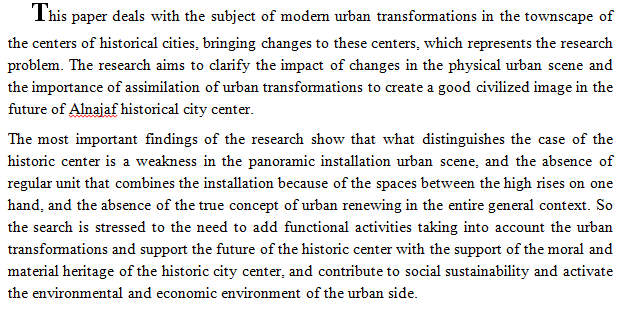
This work includes synthesis of sugar tetrazole derivative, D-ribose reacted with acetone in the presence of sulfuric acid H2SO4 to give 2, 3-O-isopropylidene-D-ribose (1). The Aldol condensation of (1) with formaldehyde in methanolic K2CO3 solution gave 2-hydroxymethyl (2, 3-O-isopropylidene-D-ribose)(2). Which was tosylated by Tosyl chloride in pyridine to yield compound (3), SN2 reaction of (3) with sodium cyanide in DMSO afforded compound (4). The [2+ 3] cycloaddition reaction of (4) with sodium azide gave the targeted compound (5). All prepared compounds have been characterized by: TLC, Specific rotation, Microelemental analysis and [FTIR and 1 H NMR spectroscopy]
In this paper the new starting material 2-(5-chloro-1H-benzo[d]imidazole-2-yl) aniline (1) was synthesized by the condensation reaction of 4-chloro-o-phenylenediamine and anthranilic acid .The new Mannich base derivatives were synthesized using formaldehyde and different secondary amines to synthesize a new set of benzimidazole derivatives(2-5). Also, the new Schiff-base derivatives (6-10) were synthesized from the reaction of compound (1) with various aromatic aldehydes and the closure-ring was done successfully using mercapto acetic acid to get the new thiazolidine derivatives(11-12).These new compounds were characterized using some physical techniques like:FT-IR Spectra and 1HNMR Spectra.
Propranolol is a nonselective-adrenergic blocker used in the treatment of hypertension, cardiac arrhythmias, and angina pectoris. A significant problem in propranolol therapy is that it undergoes extensive presystemic metabolism after oral administration leading to reduced bioavailability. In this study, two new propranolol derivatives have been designed, synthesized and characterized. These compounds were formed by acylation of propranolol followed by nucleophilic substitution reaction of acylated propranolol, these derivatives were analyzed for IR, CHN, melting points, and evaluated for their lipophilic properties compared with propranolol. The lower partition coefficient of these two derivatives revealed that the prodrug approach may be
... Show MoreA research include of synthesized five member ring, which has been synthesized by condensation of 2-(1-(4- hydroxyphenyl) ethylidene)hydrazine-1-carbothioamide[I] with α-chloro ethylacetate in sodium acetate (fused) to form ethyl 2-(4-(1-((4-oxo-2-thioxopyrrolidin-3-ylidene)hydrazono) ethyl)phenoxy)acetate [II]. After that reacted [II]with hydrazine hydrate to resulting compound [III]. Compound [III] was refluxed with 4-aminobenzoicacid in excess of phosphorus oxy chloride give compound [IV],the later compound [IV] interact with acetyl acetone or ethylacetoacetate give to pyrazole and pyrazoline derivatives[V],[VI]. While when reacted with different aromatic aldehydes and one ketone consistence Schiff base derivatives [VII]a-e . The FTIR a
... Show MoreSystole merazvensis sp. n. from Iraq, is described, figuri4 and differentiated from ,other species of the genus Systok.
This work contain many steps starting from esterification of isophthalic acid to yield diester compound [I] which was converted to their acid hydrazide [II], then the later compound reacted with ethylacetoacetate to yield pyrazol-5-one compound [III]. Afterword added acetyl chloride to give the compound [IV], the reaction of this compound with theiosemicarbazide led to produce a new carbothioamide compound [V], which was reacted with ethyl chloro acetate to yield the thioxoimidazolidin compound [VI]. The condensation reactions of this compound with different substituted aldehyde give new alkene derivatives [VII] ad. The synthesized compounds were characterized by melting points, FT-IR, 1H-NMR and Mass spectroscopy.
This work includes two steps of synthesis, the first one is the synthesis of indole which was prepared according to literature of the reaction of phenyl hydrazine with acetaldehyde in glacial acetic acid afforded phenyl hydrazone of acetaldehyde , this product was fused with zinc chloride to give the indole.Reaction of cyclohexanone with phenyl hydrazine using the same procedure for the preparing giving 1,2,3,4-Tetrahydrocarbazole.Second step involved synthesis of a series of (17) of mannich bases derivatives of indole and 1,2,3,4-Tetrahydrocarbazle. Mannich reaction involves the condensation of aldehyde usually formaldehyde with different secondary amine and with compound containing an activated hydrogen.The reaction illustrated by the fo
... Show MoreAdvanced drug delivery systems offer undeniable benefits for drug delivery. In the past three decades, new methods have been proposed to develop a novel carriers for drug delivery. Nowadays, the major goal is to maximize therapeutic benefit while minimizing side effects. Drug delivery technique is clearly shifting from the micro to nanoscale. Nano-drug delivery systems (NDDSs) are the most promising approach utilized to improve the accuracy of drug delivery and the efficacy of drugs.In this narrative review article, we evaluate how delivery challenges associated with commercial marketed products and discuss newer DDS is being carried out to overcome these challenges .Different colloidal carrier systems such as carbon nanotube ,li
... Show More (2)
(2)
The antimicrobial activity of two naphthoquinone semicarbazone derivatives (Two newly synthesized compounds) have been studied by using tube — diluation and disc plate technique. The effect of those derivatives upon pathogenic microorganism iso-lated from specimen(urine iwounds,stool, swabs, throat ....etc) have been studied also in comparison with the antibiotics (amikacin,ampicillin, carbencillin, cephalothin, cefoxitin,clindamycin ,erythromycin,gentamycin,penicillin,tetracylin and tri-methoprim. It was shown that derivative(1) had more effective against micro organ-ism than derivative(11).

